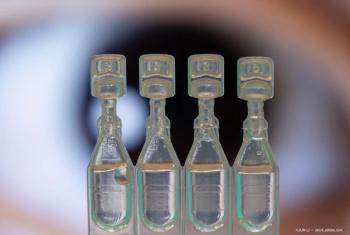
Ribonucleotide aids post-graft healing
Results from a pilot study suggest that topical treatment with the ribonucleotide GS-101 is safe for reducing corneal neovascularization in certain patient populations.
Valencia, Spain-Results from a prospective pilot study suggest that topical treatment with the ribonucleotide GS-101 (Gene Signal) is safe and effective for reducing corneal neovascularization in eyes that have undergone penetrating keratoplasty, said Salvador Garcia-Delpech, MD.
Follow-up with serial anterior segment photography during treatment showed nearly all patients had evidence of regression of the existing neovascularization beginning at 3 weeks into treatment. Over time, further improvement was noted in all eyes, and complete resolution of the corneal vessels occurred in five eyes.
"Corneal neovascularization is a significant problem that reduces corneal transparency and is an important risk factor for immune rejection in eyes with a corneal graft," said Dr. Garcia-Delpech, who is on the staff of the hospital. "Corneal neovascularization develops as a result of inflammation and hypoxia, and recent interest in treating ocular neovascularization has focused on the use of anti-VEGF agents. GS-101 represents a novel agent that targets expression of insulin receptor substrate-1 (IRS-1).
"Our experience with GS-101 is promising," he said. "More studies in larger patient populations and with longer follow-up are needed."
GS-101 is an antisense oligonucleotide that specifically blocks the synthesis of IRS-1 by selectively binding to IRS-1 mRNA. The IRS-1 gene is overexpressed in pathological angiogenesis, and IRS-1 acts as an upstream regulator of new vessel formation by inducing production of various proangiogenic compounds, including VEGF and interleukin-1-beta. GS-101 prevents the expression of IRS-1 to interrupt the pathologic IRS-1 mediated signaling.
"In contrast to currently available antiangiogenic agents that act by binding to VEGF to prevent VEGF binding to its receptor, GS-101 interferes with the angiogenic pathway by modulating protein production upstream," Dr. Garcia-Delpech said.
"Research conducted in an animal model with experimentally induced corneal neovascularization has shown that GS-101 modulation of IRS-1 expression inhibited new vessel formation and was associated with a 42% decrease in interleukin-1 and a 50% reduction in VEGF expression," he said.
FYI
Salvador Garcia-Delpech, MD
E-mail:
Dr. Garcia-Delpech and his co-authors have no financial interest in the material presented.
Newsletter
Don’t miss out—get Ophthalmology Times updates on the latest clinical advancements and expert interviews, straight to your inbox.













































.png)


